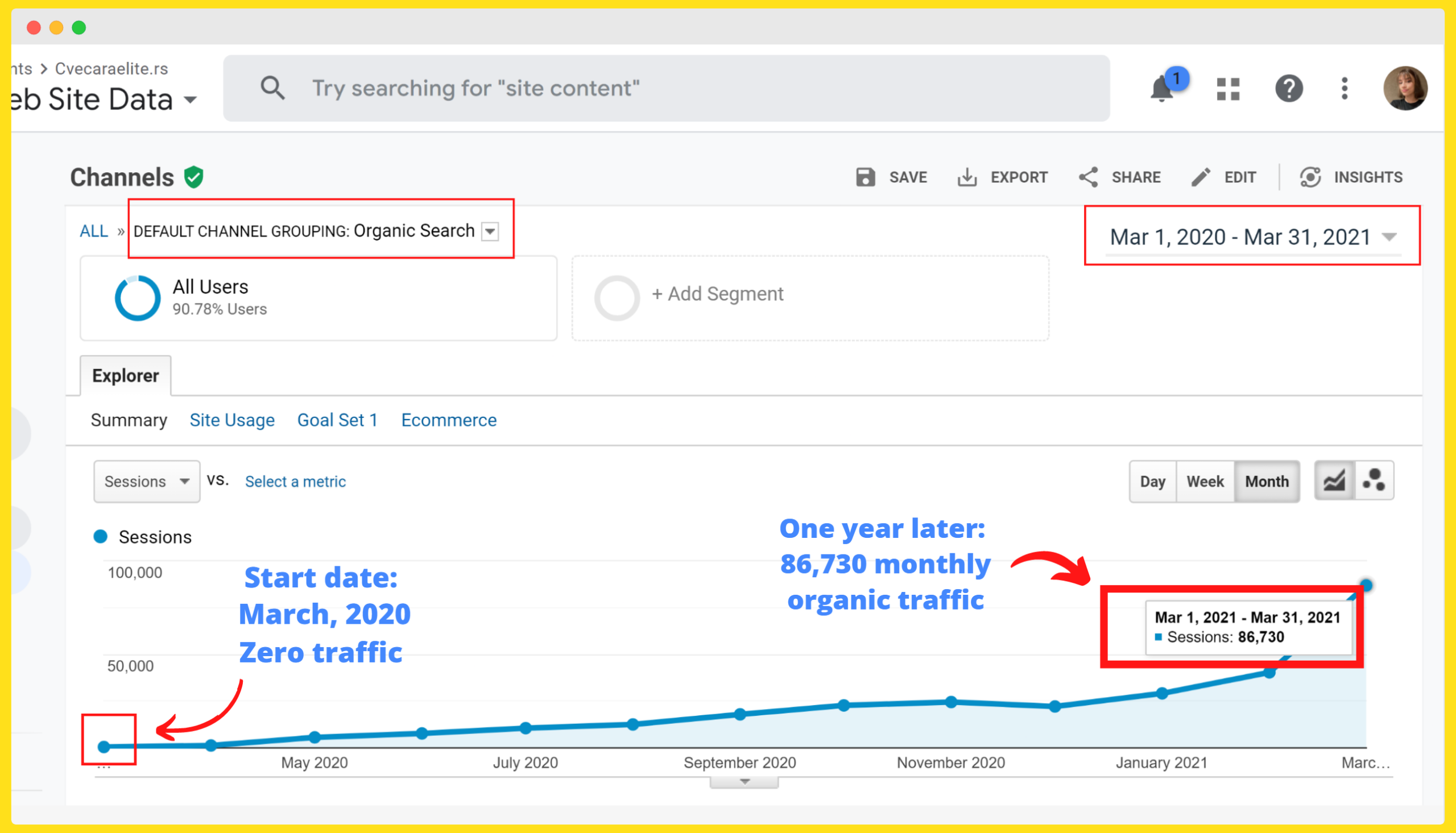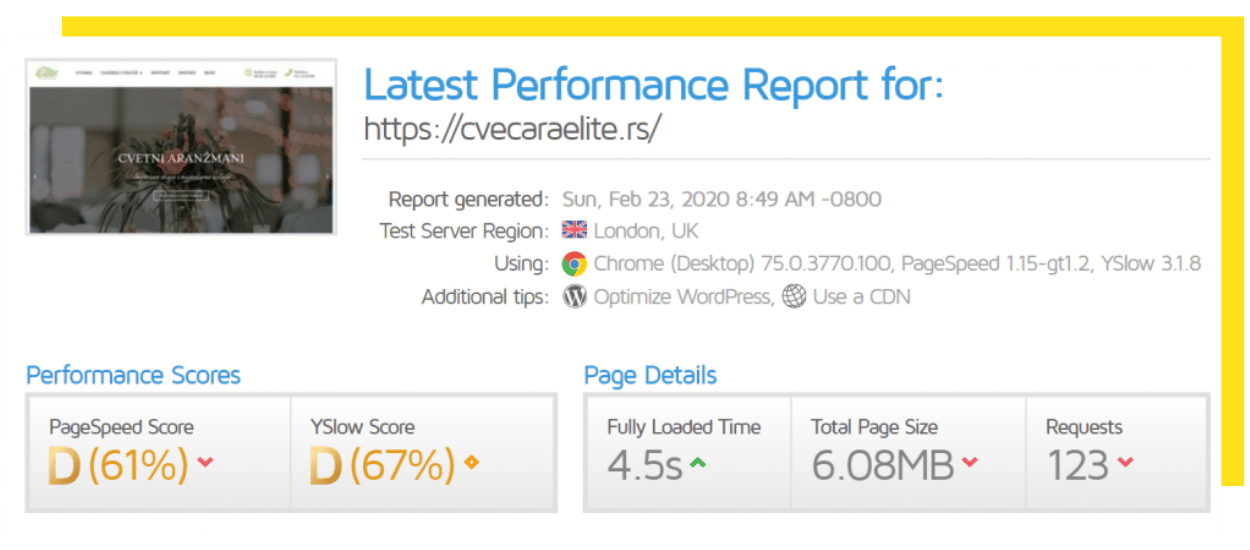Ever wondered how a brand with no online presence can strategically beat its competitors and become the new market leader despite them being years ahead content-wise?
I’m about to show you how we did it.

Currently, the website is generating 80k+ organic visitors but we’ve lost Google analytics access. It also converts dozens of visitors to loyal customers every week.
Want the golden nuggets right away?
TLDR:
- Perform in-depth Market research & Customer Research.
- Craft a detailed ICP.
- Engineer an SEO Strategy that will immediately start generating some traffic.
- Make sure your website is technically sound before publishing content.
- Start writing content that is better than everyone else’s – Make sure your outline is golden before writing the body.
- Create a distribution strategy.
- Use the right tools to speed up the process.
See I didn’t talk about backlinks? I’ll explain why.
After reading this case study, you will have an overall understanding of how we started generating traffic and bringing leads within days to a brand new website with little to no authority.
Client background
Before we discuss the exact strategies, it’s important to provide some context.
Our client is a flower shop located in Belgrade, Serbia, a country with a population of around seven million people, and not everyone there is accustomed to using the internet to find solutions to their needs.
The website is written in the Serbian language limiting the number of monthly visitors it’s possible to generate.
Our client had no website, a weak social media presence, and customers couldn’t find them online (even if they tried).
We knew we had a lot to do.
Performing in-depth Market research & Customer Research
Essentially, we needed answers to the following questions:
- What are the client’s business model and its goals?
- Who are the competitors, and what are they doing?
- What is our USP?
- How do we differentiate? Think blue ocean strategy.
- Who are our target customers, and what are their pains and desires.
- What is the industry’s state? (SWOT and PESTEL analysis, emotional SWOT, etc.)
We knew that market research and understanding our customers will be vital to constructing an SEO strategy that will complement our differences, highlight our strengths, and convey the right message.
Crafting a detailed ICP (Ideal Customer Persona)
After understanding who our customers are, we created an ICP that will simplify for us:
- Who we are writing for
- What do they actually want?
- How to convey the right message with the right tone?
Based on research, the ideal customer for this client was:
- A women
- 20-55 of age (on average)
Sure, men are also our potential audience, but the primary customer persona is a woman. Later, Google Analytics confirmed this to be the case:

This information helped design the website structure, layout, font design, font size, writing style, and a whole lot more.
It helped us construct an authentic brand voice/tone, more specifically, website copy and blog content.
SEO strategy
The SEO strategy was, arguably, the most critical aspect of this project.
In general, it came down to:
- Performing keyword research & discovering the biggest opportunities.
- Turning keywords into relevant topics.
- Constructing golden outlines.
- Writing content that’s better than anyone else’s.
- Having a technically optimized website.
- Content distribution.
Keyword Research & Discovering Opportunities
Before starting, we brainstormed all potential ways a customer can come in contact with the brand.
In this client’s case:
- Are potential customers searching for flower shops directly? Perhaps.
- Are they looking for product pages to order flowers? In many cases, yes.
- Do they already have a flower at home and are looking to learn about its origin, maintenance, tips & tricks, and who to call if they need extra help? Most definitely.
With that in mind, we’ve researched many, many flower types that our client sells (or will in the future) and checked for their monthly search volume.
If our client had the product (a specific flower/plant type), we would add it to our list of keywords to research.
The end results?
A list of flower/plant types (in keyword form) that customers were curious about.
Pricing, flower/plant’s origin, how to take care of it, useful tips and tricks in general.
We’ve carefully listened to our target customers’ needs and used their input (commonly found on forums, groups, and different communities) to create content series templates.
Turning keywords into relevant topics
You might think that after creating a list of high-volume keywords the next step is to start writing.
But, you would be wrong.
Keywords rarely explain what your article should be about. In fact, it is often misleading.
Always perform a quick ‘target keyword’ search to better understand what’s already ranking for the top positions and what Google is rewarding.
- Do you see many product pages in your results?
- Do you see youtube videos?
- Do you see content that is informative in nature (guides, how-to articles, news, etc.)
This information can directly impact what page you end up making.
These are direct hints on what the people are interested in and what your content page should be like.
Writing Content That’s Better Than Anyone Else’s
Excellent content doesn’t need to have 5000 words. Sometimes, the fewer words, the better.
When you’re focused on delivering an optimal user experience, it’s always quality over quantity. A 5000-word article might have ALL of the information on a specific topic, but does the reader really need that much information?
Does your average reader even have time to read a 5000-word article? Probably not.
Your writer will need to know what the reader’s intent is and how to answer it in the right way.
This is one of the reasons why it’s crucial to hire the right writer.
Of course, many topics on the internet don’t explain everything in-depth, and if there’s a topic that your potential customers care a lot about, your website should answer it better than your competitor.
This also explains why you will often write content that is lengthier than your competitor’s – it provides more value.
Watch out for these factors when analyzing an article that’s already ranking well for your target keyword:
- Does the article answer the question a reader is looking for? Answering the questions people have, and addressing their concerns and pain points will help your content stand out and be unique. Sometimes you can write an entire blog post or series of blog posts based on users’ questions and concerns.
- Does it provide a good user experience? Is there a table of contents? Is the content easily scannable? Visual representations? Infographics? Is it understandable?
- Is the article straightforward and actionable? It is not enough to just answer questions. You also need to provide all the possible solutions for each problem.
- Is it up to date? Depending on the industry, content ages at different rates. Make sure you update your statistics and information promptly. It will also boost your rankings and credibility.
Having a Technically Optimized Website
You probably think that a technically optimized website requires heavy-duty coding skills.
That’s not always true.
If you’re on WordPress, for example, the right set of plugins can get you on the right path with zero coding skills required. If you’re using something else, there are probably built-in solutions for you, OR you’ll need 3rd party help.
Essentials of technical optimization are:
- A website that is fast enough to not ruin the user experience.
- Make it crawlable for search engines.
- Avoid 404 pages and duplicate content, and you’re good to go.
Of course, that’s not all, but it’s a good start.
We took our client’s website from this:

To this:

We reduced loading time from 4.5 sec to 1.2 sec – more than halved the total page size and reduced the number of (resource) requests needed to load the page 100%.
Backlinks & content distribution
Backlinks are important. Period.
Backlinks send signals to search engines that other websites refer to your content for some value that it brings. But, these days Google doesn’t solely rely on backlinks to judge the quality of the content.
You don’t need backlinks 100% of the time, but you will need excellent content for the top position once you reach it.
For your content to be seen, it’s vital to have a proper content distribution strategy in place.
Here’s what we did for our client:
- We shared content with all relevant, local flower-related forums and communities.
- We utilized Facebook groups to engage with the community and distribute content.
- We created a business page on Pinterest and pinned every image from every post we wrote. This was quite consuming and very effective with companies operating internationally.
Depending on your niche, it’s really about finding online places where your community spends time at. For example, if you have a SaaS product, then communities on Linkedin, GrowthHackers, Zest, Quora, and various Facebook groups may be the perfect fit for you.
What tools did we use?
Our most important tools were:
- Ahrefs – our go-to tool for keyword research, backlinks, and SERP analysis.
- SemRush – great for understanding topics better and getting semantically related keywords and topics.
- Also Asked – visually represents related topics.
- Ask the public – does the same as Also Asked, but more in-depth.
- Screaming Frog – Identifies website technical problems we might’ve missed.
- GTMetrix – provides actionable insight on how technically optimized your website is from a speed perspective.
Conclusion
If you’re curious about any part of our strategy (that we didn’t mention), do reach out.
If you’re looking to take your content marketing to the next level, let’s get in touch.


